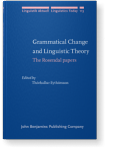Martin Maiden
List of John Benjamins publications for which Martin Maiden plays a role.
Journal
Book series
Titles
Historical Linguistics 2022: Selected papers from the 25th International Conference on Historical Linguistics, Oxford, 1–5 August 2022
Edited by Holly Kennard, Emily Lindsay-Smith, Aditi Lahiri and Martin Maiden
[Current Issues in Linguistic Theory, 369] 2025. vi, 305 pp.+ index
Subjects Historical linguistics | Theoretical linguistics
Linguistic Theory and the Romance Languages
Edited by John Charles Smith and Martin Maiden
[Current Issues in Linguistic Theory, 122] 1995. xiii, 240 pp.
Subjects Romance linguistics
2025 日本言語政策学会 / Japan Association for Language Policy. 言語政策 / Language
Policy 10. 2014 Historical Linguistics 2022: Selected papers from the 25th International Conference on Historical Linguistics, Oxford, 1–5 August 2022, Kennard, Holly, Emily Lindsay-Smith, Aditi Lahiri and Martin Maiden (eds.), pp. 1–4 | Chapter
Policy 10. 2014 Historical Linguistics 2022: Selected papers from the 25th International Conference on Historical Linguistics, Oxford, 1–5 August 2022, Kennard, Holly, Emily Lindsay-Smith, Aditi Lahiri and Martin Maiden (eds.), pp. 1–4 | Chapter
2018 New thoughts on an old puzzle: The Italian alternation type dissi, dicesti ; feci, facesti Revue Romane 53:2, pp. 217–260 | Article
This study addresses the peculiar pattern of root-allomorphy exhibited by the Italo-Romance preterite. Stimulated by a recent study by Mark Elson, which depends on upholding the traditional view that the phenomenon in Italo-Romance is attributable to sound change and to the subsequent analogical… read more
2014 Two suppletive adjectives in Megleno-Romanian Revue Romane 49:1, pp. 32–52 | Article
This study involves the existence in Megleno-Romanian dialects of a lexically suppletive distinction between singular and plural forms of the adjectives meaning ‘small’ and ‘big’. The phenomenon has gone largely unnoticed both by comparative Romance linguists and by morphological theorists yet it… read more
2013 The Latin ‘third stem’ and its Romance descendants Diachronica 30:4, pp. 492–530 | Article
The ‘third stem’ in the Latin verb provides one of Aronoff’s best-known illustrations of the notion of ‘morphome’: unpredictably variable in form, it is also consistently associated with an abstract and heterogeneous pattern of distribution. My perspective is diachronic, exploring the history of… read more
2012 A paradox? The morphological history of the Romance present subjunctive Inflection and Word Formation in Romance Languages, Gaglia, Sascha and Marc-Olivier Hinzelin (eds.), pp. 27–54 | Article
A major morphological innovation in the Latin-Romance transition was the appearance of alternations in the root of the verb. This study examines the complex morphological evolution of the alternants which arose from proto-Romance palatalization and became characteristic of the present subjunctive… read more
2009 Imperative morphology in diachrony evidence from the Romance languages Historical Linguistics 2007: Selected papers from the 18th International Conference on Historical Linguistics, Montreal, 6–11 August 2007, Dufresne, Monique, Fernande Dupuis and Etleva Vocaj (eds.), pp. 99–108 | Article
This paper presents an initial comparative-historical synthesis of Romance affirmative imperative morphology. It explores its implications for morphological change generally. Imperatives emerge as a recurrent locus of suppletion and defectiveness, which can uniquely escape morphological changes… read more
2008 Lexical nonsense and morphological sense: On the real importance of 'folk etymology' and related phenomena for historical linguists Grammatical Change and Linguistic Theory: The Rosendal papers, Eythórsson, Thórhallur (ed.), pp. 307–328 | Article
2004 Into the past: Morphological change in the dying years of Dalmatian Diachronica 21:1, pp. 85–111 | Article
This study is concerned with Vegliote, the last remnant of the Dalmatian branch of the Romance languages, as used by its very last speaker in the last quarter of the 19th century. Specifically, I shall deal with a peculiar morphological neutralization of the distinction between present and past… read more
2000 Phonological Dissimilation and Clitic Morphology in Italo-Romance Phonological Theory and the Dialects of Italy, Repetti, Lori (ed.), pp. 169–190 | Article
1999 34. Romance Historical Morphology and Empty Affixes The Emergence of the Modern Language Sciences: Studies on the transition from historical-comparative to structural linguistics in honour of E.F.K. Koerner, Embleton, Sheila, John E. Joseph and Hans-Josef Niederehe (eds.), pp. 189–202 | Article
1998 Towards an Explanation of some Morphological Changes which ‘Should Never Have Happened’ Historical Linguistics 1997: Selected papers from the 13th International Conference on Historical Linguistics, Düsseldorf, 10–17 August 1997, Schmid, Monika S., Jennifer R. Austin and Dieter Stein (eds.), pp. 241–254 | Article
1995 Evidence from the Italian dialects for the internal structure of prosodic domains Linguistic Theory and the Romance Languages, Smith, John Charles and Martin Maiden (eds.), pp. 115–132 | Article
1993 The Role of Paradigms in the Phonetic Detail of Sound Change Historical Linguistics 1989: Papers from the 9th International Conference on Historical Linguistics, New Brunswick, 14–18 August 1989, Aertsen, Henk and Robert J. Jeffers (eds.), pp. 283–296 | Article













